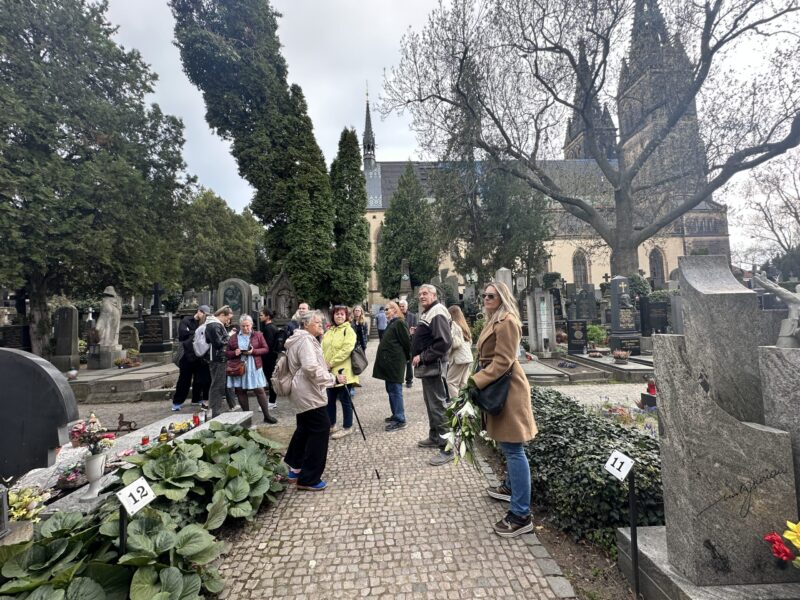Milada Horáková
The story of
Democracy & love
Winston Churchill, Albert Einstein, and others pleaded for her release. Yet, this lawyer, politician, and fearless advocate for women's rights, justice, democracy and love was executed by the communist regime. In 2025, at Vyšehrad Cemetery, the resting place of Czech national elites, we will commemorate 75 years since her execution.
Commemoration of Milada Horáková: A Tribute to Justice and Freedom
Date and Time:
15. April 2025
16:00
Cemetery in Which Activity Will Take Place:
Vyšehrad Cemetery (Vyšehradský hřbitov)
Meeting at the Basilica of St. Peter and St. Paul in Vyšehrad.
15
April 2025
16:00
Vyšehrad Cemetery
Milada Horáková - the woman who would not bend
A multicultural, intergenerational gathering at the symbolic grave of Dr. Milada Horáková, executed 75 years ago for defending democracy and human rights. Her story, once backed by Churchill and Einstein, reminds us of the cost of peace and freedom.
A lawyer, politician, and mother, Milada Horáková became a symbol of courage and moral integrity. She resisted both Nazism and Communism, refusing to betray her beliefs—even under the threat of death. Her final words, “I am falling, I am falling...,” still echo as a chilling reminder of the price of truth. Executed in 1950 after a show trial, her legacy lives on in the fight for freedom, democracy, and human rights.
Reflection on the Commemorative Act for Milada Horáková: Memory, Media, and Performativity in the Digital Age
The commemorative event for Milada Horáková, symbolically held at her fictional grave at Vyšehrad, is not only a remembrance of a historical figure but also a media and performative event with deeper cultural and political dimensions. Since the event brings together students of the University of the Third Age (A3V) and master's students of the New Media Marketing program, it offers a unique opportunity to connect a commemorative gesture with reflection on public communication, propaganda, and PR in both historical and contemporary contexts.
Milada Horáková and the Media Staging of Power
The 1950 trial of Milada Horáková is often cited as a prime example of a political show trial, intended not to deliver justice but to consolidate power. The regime used all available communication channels to create an illusion of legitimacy and public support. The accusations were spread through radio, daily newspapers, posters, and petitions—tools aimed not only at discrediting the accused but also at mobilizing public displays of loyalty to the regime.
This "staged justice" (in the sense used by Hannah Arendt) served as political theatre where facts mattered less than effects—fear, obedience, and control over the narrative. Communist propaganda systematically used language, imagery, and emotion—the very tools that we now analyze in marketing and media communication. That is why reflecting on these events holds great value for today’s media students; it reveals how structured messaging can deeply shape reality.
Digital Media, Democracy and Truth
Today’s media landscape has changed radically. The internet, social media, and digital technologies have democratized access to information but also brought new challenges—disinformation, post-truth, and algorithmic content filtering. While 1950s propaganda operated in a centralized way, today’s is decentralized, often hidden, and masked as entertainment, opinion, or personal expression.
From the perspective of New Media Marketing, it is crucial to observe not just the evolving forms but also the strategies used to influence public opinion. The experience of historical propaganda—such as the Horáková trial—can serve both as a warning and an inspiration. It reminds us that media are never neutral—they always carry ideological weight, whether consciously or unconsciously.

Remembering Milada Horáková through the commemorative event at Vyšehrad is more than a remembrance. It is a starting point for deeper reflection on how communication evolves, how public space is shaped and misused, and what role we play in all this—as citizens, as media users, as students.
In an era when reality can be easily manipulated through images and narratives, it remains essential to return to truth—even when it is complex, uncomfortable, or painful. And to remember that the ability to listen, to think critically, and to meet face-to-face may be the most powerful expressions of democracy we have today.
The commemorative event is organized by students of the University of Finance and Administration in Prague and the Svatobor Association.
The gathering was held at the symbolic grave of Dr. Milada Horáková, located at the Vyšehrad Cemetery in Prague. This cemetery is the final resting place of the Czech Republic’s cultural and scientific elite. Among those buried here are some of the most prominent figures of the 19th century, such as Alfons Mucha, Ema Destinn, Karel Čapek, Antonín Dvořák, and many other.
